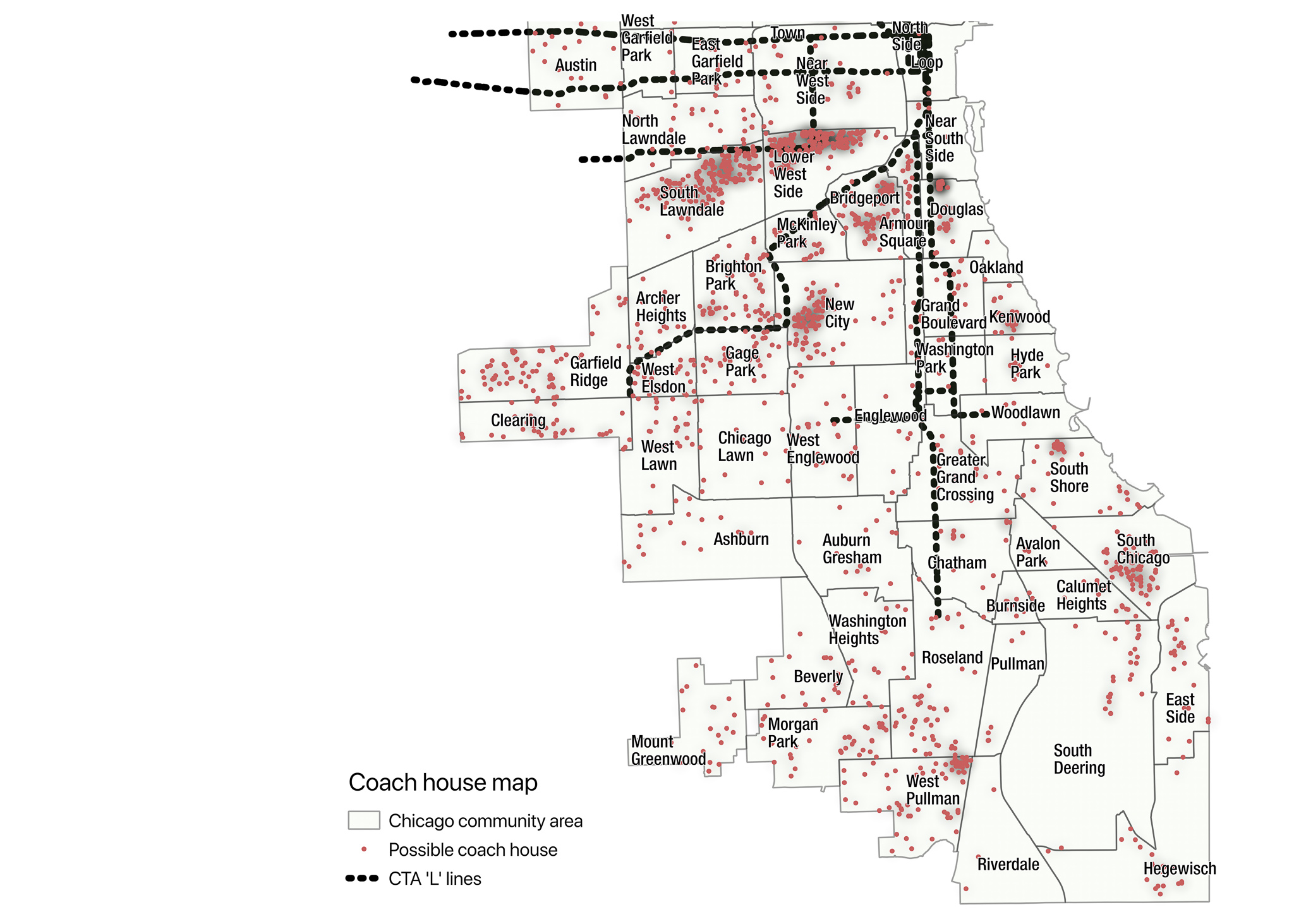This spring, City Council could consider lifting the ban on “accessory dwelling units” in Chicago. Accessory dwelling units, or ADUs, are a form of apartment most commonly seen in Chicago’s neighborhoods as coach houses behind a bigger house (also called rear houses if the main building doesn’t have a garage). Other types include attic and basement apartments. They’re known as “granny flats” and “laneway houses” in other cities.
Coach houses are prevalent on the South Side. The Lower West Side and South Lawndale community areas have the plurality of existing coach houses, with 412 potential coach houses. (There is no official registry, so these are estimated figures based on Chicago building footprint and OpenStreetMap data.) Yet New City, Bridgeport, West Pullman, and South Chicago are no slackers, with 359 potential coach houses.
New coach houses and rear houses haven’t been legal in Chicago since 1957, when the zoning code outlawed second (“accessory”) buildings on lots. (According to the Tribune, city planners were worried that overcrowding, at a time when Chicago was hitting its peak population, might lower property values.) The nearly 3,000 existing coach houses are allowed to remain, but they can’t be expanded up or out. In fact, renovations for upgrades and maintenance can be tricky: if they take longer than a year to finish, and no one has been renting the coach house out during that time, the zoning code says it cannot be rented out again.
The city’s new five-year housing plan, approved this past December, includes a policy to legalize accessory dwelling units. The Department of Planning & Development has drafted legislation, but it hasn’t been introduced yet.
ADUs, particularly if legalized, have a number of benefits. I’d like to promote these five:
- Increase the supply of affordable housing. Coach house apartments are generally smaller and older, meaning they have lower rents.
- Increase income for homeowners. Two and three-flat owners already have an income opportunity, but one more unit can bring in an additional tenant. Single-family homeowners can also rent out a small, new building in the backyard without having to modify the main house.
- Support “aging in place” and multigenerational housing. ADUs give families flexibility to share property and living space with extended family members.
- Increase work for small and local architects and contractors. The construction of ADUs would provide more work for designers and builders who work on smaller-scale projects.
- Boost local businesses by creating space for and drawing in more residents to historically underpopulated areas.
Attic, basement, and garden apartments are also kinds of accessory dwelling units because they’re often smaller and rent for less. They differ from coach and rear houses because they’re in the same building as the main house, and they’re generally legal in Chicago, but hard to get permission for.
Say the owner of a two or three-flat wants to add another unit in the basement or the attic because the basement has some extra space. If their building is in a “down-zoned” area that only allows single-family houses, the owner has to go through an arduous, expensive zoning change process. The outcome, which would allow one or two more units, isn’t even guaranteed. What is guaranteed is the City of Chicago’s zoning change application fee of $1,025 and a zoning lawyer that charges at least $5,000.
I started a petition in January calling on City Council to re-legalize coach houses, rear houses, and other types of accessory dwelling units. At the time of publication, it had over 1,350 signers. Dozens of signers have left personal messages of support, indicating how re-legalizing coach houses would improve their lives. Some want the ability to earn more income, while others wanted to provide a place for immediate, extended, and older family members to live close by.
These are a few of my favorite stories—endorsements for allowing coach houses—that people sent in:
“I have a daughter with a significant developmental delay. I would like her to be able to live somewhat independently in a coach house behind my house.”
“Although we have loved having my parents in the same town (and my kids have enjoyed having their grandparents nearby), they would appreciate the independence that would come from having separate space in a coach house. It would be a great way for us to continue to have the benefits of multi-generational living (after-school childcare and communal meals), but also providing all of us more privacy and freedom.”
There are likely to be some issues that need ironing out, including coming up with ways to ensure that lower-income homeowners can access capital to pay for the construction of an income-generating accessory dwelling unit; monitoring ADUs to see how many become actual housing and how many are listed on short term vacation rental websites; and the possibility that some landlords may use the law to subdivide existing apartments and remove family-size units from the market. But cities and states across the country have legalized ADUs, and I think Chicagoans will benefit immensely when the same happens here.
Sign the petition to lift the ban on ADUs at bit.ly/CoachHousePetition.
Steven Vance is the founder and CEO of Chicago Cityscape, a real estate information service. This is his first article for the Weekly.


Did this happen?